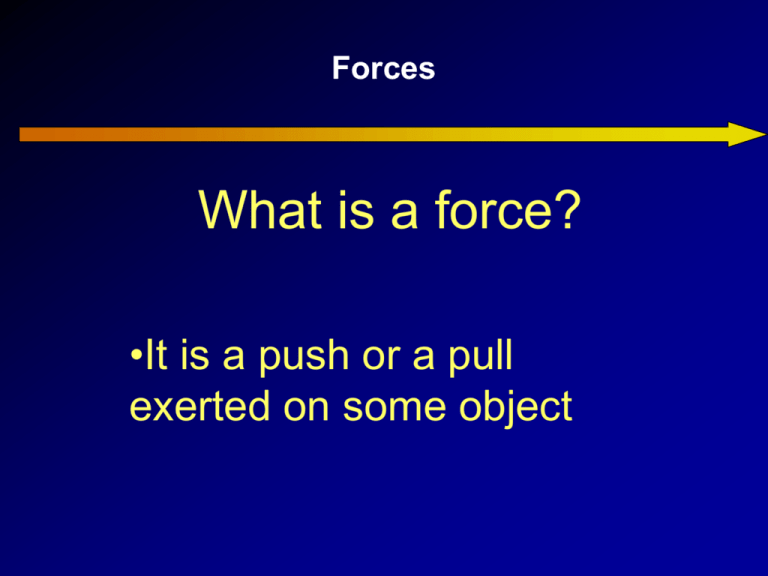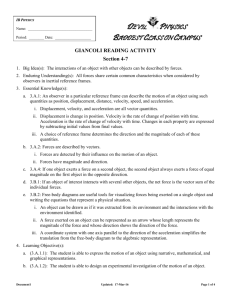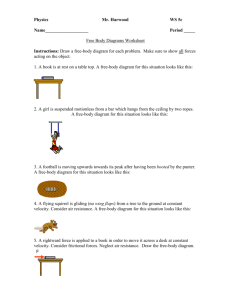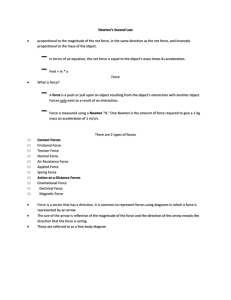Forces - Red Eagle Physics!
advertisement

Forces What is a force? •It is a push or a pull exerted on some object An applied force can cause a change in velocity • Question – what is the definition of change in velocity over time? The SI unit of force is a Newton • Newton is abbreviated “N” • The unit of a Newton is: kg . m s2 • So… think about what these units mean… Newton’s Second Law • The acceleration of an object is directly proportional to the force acting on it, and it is inversely proportional to the object’s mass. F=ma How can you tell a force is being applied? • If an object (with mass) is accelerating, there is a FORCE being applied. Which of the following is experiencing an applied force? (think about the acceleration of the object) • An object that is slowing down • An object at rest • An object that is speeding up in the negative direction • An object traveling at a constant velocity Different types of Forces • Contact Forces – These result in the physical contact of two objects • Friction • Tension • Field Forces – Forces that can exist between objects, even in the absence of physical contact between the objects. • Gravitational • Electromagnetic Gravity is a Force! • The force of gravity that is experienced by objects is known as WEIGHT. • We will be using the units of Newtons to express weight. – Calculate the weight of an object with a mass of 20kg: Newton’s First Law • An object at rest remains at rest, and an object in motion continues in motion with constant velocity (in the same direction). • Also known as the Law of Inertia Inertia • The tendency of an object not to accelerate. – The tendency of an object in motion to stay in constant motion Example: Ketchup in a bottle… • It doesn’t want to come out (it wants to remain at rest). •So then you bang it on the bottom to make it come out (apply an outside force). Basically, objects just keep on doing whatever they are doing unless they are acted upon by an unbalanced force. Net Force • Net External Force is defined as the sum of all the forces acting on an object. – Also known as: Σ Forces • An object may experience many forces, but still have a net force of zero. An object may have a net force of zero, but still experience motion! Free-Body Diagrams Free-body diagrams are used to show the relative magnitude and direction of all forces acting on an object. Free-Body Diagrams – Draw the free-body force diagram of an object that is experiencing multiple forces • 26N to the right • 32N to the left • 32N to the left • 8N to the right • 19N to the right • 19N to the left Net Force Normal Force • The Normal Force is the force exerted on one object by another that is in a direction perpendicular to the surface of contact. Free Body-Force Diagrams • Forces are vectors • Draw the free-body force diagram of a book sitting on a table • The forces can be drawn at any direction – depending which way the force is coming from! •If an object is at rest: …then the net force is zero • The force vectors in the “x” direction will equal zero. • The force vectors in the “y” direction will equal zero. – Draw the free-body force diagram of a book sitting on a desk A chair sitting on the ground has a mass of 35kg. Now, a boy over andofpushes • Draw the walks force diagram the chair. down on normal the chair with a force of 5N. – What is the force? •Draw a force diagram of this situation. •What is the normal force now? An egg is free-falling from a nest in a tree. Neglect air resistance. Draw a free-body diagram showing the forces involved. A leaf is falling from a tree to the ground at constant velocity. Consider air resistance. A free body diagram for this situation looks like… Remember the ** important concept** about balanced forces and velocity Remember the ** important concept** about balanced forces and velocity… • A rightward force is applied to a book in order to move it across a desk. Consider frictional forces. Construct a free-body diagram for the following situations: The object with constant velocity. The objectisismoving accelerating. A football is moving upwards toward its peak after having been booted by the punter. Draw a free-body diagram. Tension • Tension is the magnitude of a pulling force. • Objects that are hanging or being pulled will experience tensional forces. • If an object is static, the tensional force will be equal and opposite of the weight vector. A 30kg box is sitting on the ground (it is not moving), but it is being pulled up with a tensional force of 30N. • Draw a force diagram of the object. • What is the normal force of the ground on the object? Newton’s Third Law • If 2 objects interact, the magnitude of the force exerted on object 1 by object 2 is equal to the magnitude of the force exerted on object 2 by object 1. These two forces are equal and opposite. – Example: book sitting on a table Newton’s Third Law • “For every action there is an equal and opposite reaction.” – The forces that are mutually exerted on two objects are called an “action-reaction pair” – Action and reaction forces do not always result in equilibrium… • Hammer and nail A 6.0 kg object undergoes an acceleration of 2.0m/s2. • What is the magnitude of the net external force acting on it? • If this same force is applied to a 4.0kg object, what acceleration is produced?




